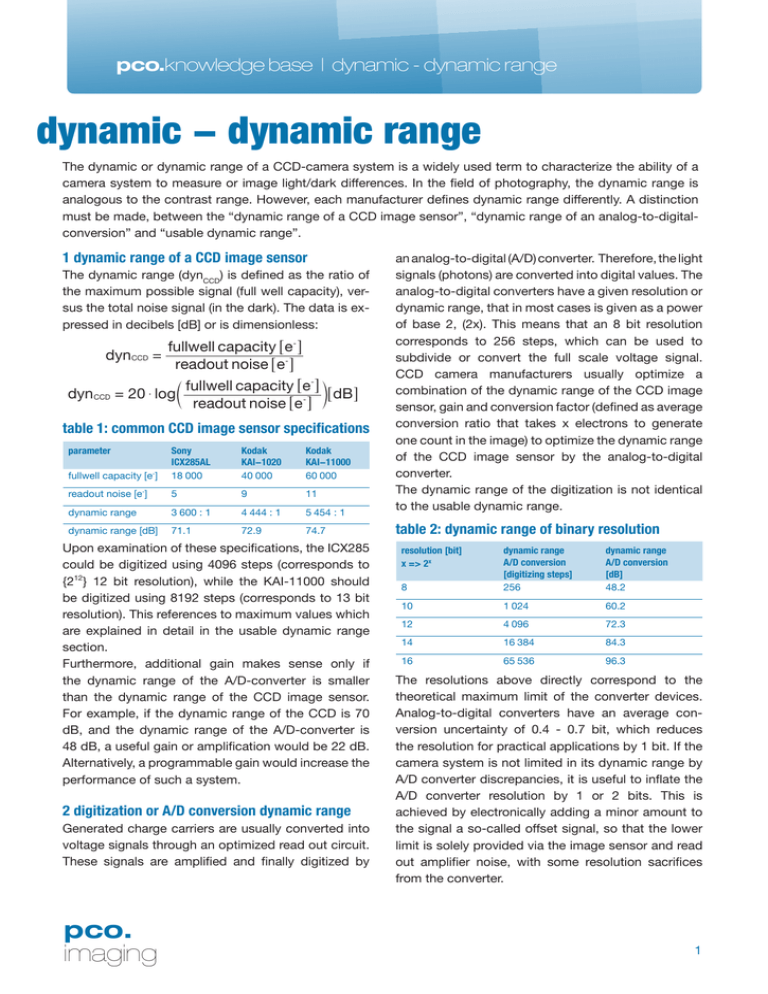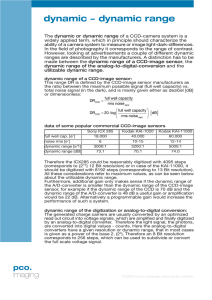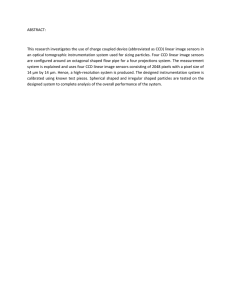dynamic range
advertisement

pco.knowledge base | dynamic - dynamic range
dynamic - dynamic range
The dynamic or dynamic range of a CCD-camera system is a widely used term to characterize the ability of a
camera system to measure or image light/dark differences. In the field of photography, the dynamic range is
analogous to the contrast range. However, each manufacturer defines dynamic range differently. A distinction
must be made, between the “dynamic range of a CCD image sensor”, “dynamic range of an analog-to-digitalconversion” and “usable dynamic range”.
1 dynamic range of a CCD image sensor
The dynamic range (dynCCD) is defined as the ratio of
the maximum possible signal (full well capacity), versus the total noise signal (in the dark). The data is expressed in decibels [dB] or is dimensionless:
fullwell capacity 6e- @
readout noise 6e- @
fullwell capacity 6e- @
dynCCD = 20 $ log c
m6dB @
readout noise 6e- @
dynCCD =
table 1: common CCD image sensor specifications
parameter
fullwell capacity [e-]
Sony
ICX285AL
18 000
Kodak
KAI-1020
40 000
Kodak
KAI-11000
60 000
readout noise [e-]
5
9
11
dynamic range
3 600 : 1
4 444 : 1
5 454 : 1
dynamic range [dB]
71.1
72.9
74.7
Upon examination of these specifications, the ICX285
could be digitized using 4096 steps (corresponds to
{212} 12 bit resolution), while the KAI-11000 should
be digitized using 8192 steps (corresponds to 13 bit
resolution). This references to maximum values which
are explained in detail in the usable dynamic range
section.
Furthermore, additional gain makes sense only if
the dynamic range of the A/D-converter is smaller
than the dynamic range of the CCD image sensor.
For example, if the dynamic range of the CCD is 70
dB, and the dynamic range of the A/D-converter is
48 dB, a useful gain or amplification would be 22 dB.
Alternatively, a programmable gain would increase the
performance of such a system.
2 digitization or A/D conversion dynamic range
Generated charge carriers are usually converted into
voltage signals through an optimized read out circuit.
These signals are amplified and finally digitized by
pco.
imaging
an analog-to-digital (A/D) converter. Therefore, the light
signals (photons) are converted into digital values. The
analog-to-digital converters have a given resolution or
dynamic range, that in most cases is given as a power
of base 2, (2x). This means that an 8 bit resolution
corresponds to 256 steps, which can be used to
subdivide or convert the full scale voltage signal.
CCD camera manufacturers usually optimize a
combination of the dynamic range of the CCD image
sensor, gain and conversion factor (defined as average
conversion ratio that takes x electrons to generate
one count in the image) to optimize the dynamic range
of the CCD image sensor by the analog-to-digital
converter.
The dynamic range of the digitization is not identical
to the usable dynamic range.
table 2: dynamic range of binary resolution
resolution [bit]
x => 2x
8
dynamic range
A/D conversion
[digitizing steps]
256
dynamic range
A/D conversion
[dB]
48.2
10
1 024
60.2
12
4 096
72.3
14
16 384
84.3
16
65 536
96.3
The resolutions above directly correspond to the
theoretical maximum limit of the converter devices.
Analog-to-digital converters have an average conversion uncertainty of 0.4 - 0.7 bit, which reduces
the resolution for practical applications by 1 bit. If the
camera system is not limited in its dynamic range by
A/D converter discrepancies, it is useful to inflate the
A/D converter resolution by 1 or 2 bits. This is
achieved by electronically adding a minor amount to
the signal a so-called offset signal, so that the lower
limit is solely provided via the image sensor and read
out amplifier noise, with some resolution sacrifices
from the converter.
1
pco.knowledge base | dynamic - dynamic range
dynamic - dynamic range
3 usable dynamic range
The actual usable dynamic range of a camera system
is determined by the general settings or adjustments
of the system (e.g., the quality of the dynamic range
of the CCD sensor, and the compatibility between the
read out circuit’s dynamic range or digitization). For
example, if a full well capacity of 18 000 electrons with
a CCD image sensor dynamic range ratio of 4500:1 is
given, getting optimal range with a 12 bit A/D converter
(4096 gray levels) is possible with a conversion factor
of 4.4 electrons per step (count ). For very low noise
cameras, it is sometimes advantageous to shift the
signal resolution towards the lower noise limit and
ignore the total dynamic range of the CCD image
sensor, particularly if it is of minor interest in the specific application.
A particular application can also influence the usable
dynamic range. Although some manufacturers attempt
to define their dynamic ranges as being independent
of application, these applications have a direct effect
on the limits of the dynamic range. For example, in
medium to high light level applications, which are
photon noise limited, the intrascene dynamics may be
smaller than the system’s dynamic range.
and scaling, the image can only be processed by the
human eye, using the unique capabilities of the human
brain, and could not be image processed in a computer.
Figure 1
Weakly illuminated image with 12bit total dynamic displayed with
255 gray levels. scaled: 0-4095 -> 0-255 graph shows readout line
Figure 2
Same image as above with 12bit total dynamic displayed with 255
gray levels. scaled: 53-70 -> 0-255 graph shows readout line
4 comparing 12 bit and 8 bit dynamic range
This low light application example was recorded using
a 12 bit cooled CCD camera system. The full scale,
12 bit image is completely dark. However, when the
image is scaled to the 54-76 counts range, the image
becomes visible. Although noise can be seen due to a
weak light signal, the image can be clearly seen. Under
similar conditions, but recorded with an 8 bit system
Figure 3
Same image as above but with 8bit total dynamic displayed with
255 gray levels. scaled: 7-9 -> 0-255 graph shows readout line
europe
america
PCO AG
Donaupark 11
93309 Kelheim, Germany
The Cooke Corporation
6930 Metroplex Drive
Romulus, Michigan 48174, USA
fon +49 (0)9441 2005 50
fax +49 (0)9441 2005 20
info@pco.de
www.pco.de
tel (248) 276 8820
fax (248) 276 8825
info@cookecorp.com
www.cookecorp.com
pco.
imaging
subject to changes without prior notice | ©PCO AG, Kelheim | dynamic - dynamic range | v. 0810
2


